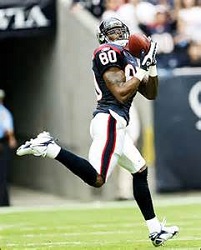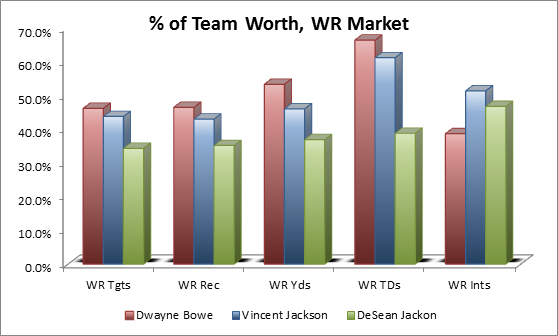[adsenseyu1]
Per Ian Rapoport the talks surrounding Houston Texans wide receiver Andre Johnson are heating up again. With that in mind let’s look at the salary cap and cash considerations surrounding a move.
Because we are now past June 1, Johnson’s “dead money” will split between 2014 and 2015, which makes the contract reasonable for the Texans to trade. Currently Johnson counts for $15,644,583 against the Houston Texans salary cap and $11 million against their cash payroll. If traded or released his cap charge would reduce to $4,644,583 in 2014, an $11 million savings. In 2015 his cap would drop from $16,144,583 to $7,319,583, an $8.825 million savings.
For a rebuilding team this is a no brainer decision. The Texans have a major contract extension on the horizon with JJ Watt. Watt is going to look to earn in the ballpark of the $16 million a year Mario Williams earned from the Buffalo Bills. Trading Johnson will create a total of $19.825 million in cap room over the next two seasons, which is a huge number. The payroll savings of $21.5 million (Johnson has already forfeited a $1 million roster bonus due in September that was contingent on offseason participation and likely another $250,000 also tied to workouts) would easily cover a bonus for Watt.
The difficult part of the trade is finding a trade partner. Johnson’s $33.5 million in remaining salary, regardless of how good he has been, is a high figure for a 33 year old receiver. The team trading for him would need to have enough cap space to take on a at least a $10 million cap hit in 2014 or restructure the contract to lower the cap charge. In addition that team would likely need to reinstate the lost $1 million bonus bringing the cap hit to $11 million.
Restructuring a contract (which any player will do) would mean paying Johnson a large portion of his $10 million salary in the form of a signing bonus. That would not only make Johnson more difficult to release in the future but would likely increase his cap charges in 2015 and 2016 to $14 and $15 million a season. Teams could reduce those numbers slightly by adding voidable seasons to the contract, but that would be locking themselves into future dead money.
NFL.com speculated on a few landing spots. Here are some thoughts on a few of them
New England Patriots
The team is currently $6.4 million under the cap so they would need to create nearly $5 million in cap room to execute the trade and $8 million in cap room to just function for the year. The Patriots have already made one big move when they signed Darrelle Revis to a “buy now, pay later” type of contract, so that would likely be the way they would work with getting Johnson under the cap. The team has very few, if any, candidates for restructure to facilitate a trade.
Carolina Panthers
The Panthers have one of the worst group of receivers in the NFL, but they just recently let the older Steve Smith walk away and the Panthers were not very active in trying to replace him. That makes it hard for me to believe that they would be interested here. Financially it would be difficult. Carolina still has one of the worst cap situations in the NFL and just $4.8 million in cap space. The team needs to consider a longer term extension for Cam Newton and Greg Hardy. I can’t see the financial match.
Cleveland Browns
I’m not sure how Johnson can spin this as playing for a contender, but the Browns have $24 million in cap space making the contract an easy one to take on. This could be an intriguing trade and I would wonder if Josh Gordon would be involved. Gordon is a high upside player that could be suspended for the season. Houston could consider him and a draft pick as fair compensation. If Gordon was to never play again the Texans would at least have the opportunity to recover the bonus money paid to him by the Browns.
New York Jets
The Jets have a need for a wide receiver and they have already added a few one year veteran contracts to the team in Mike Vick and Chris Johnson. Because the Jets have over $20 million in cap space they could bring Johnson in and not saddle themselves with future dead money. Having Johnson on the team would allow the Jets to quickly evaluate Geno Smith and if they think Johnson could have some trade value in 2015 if things don’t work out they might not have a lot to lose.
Oakland Raiders
This reunites Johnson with Matt Schaub and the Raiders are essentially a one or two year “for hire” program right now. Again this isnt exactly going to a contender, but they have the veteran infrastructure in place to at least consider it a possibility. Oakland has just over $10 million in cap room, so they may have to tinker slightly with the contract to give them an operating budget in September, but that would not be a dramatic departure from their current contract constructions.
Baltimore Ravens
Baltimore already has receivers in place and with just $4 million in cap space it is hard to see them being able to absorb his contract. They have a number of high future cap charges in place an it’s not likely they want to add another one here.
[adsenseyu2]
[adsenseyu4]
[subscribe2]



